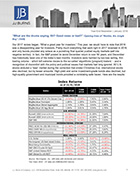“It’s the same old story / Same old song and dance, my friend” Aerosmith, “Same Old Song And Dance”
For the third consecutive year we begin our review marveling at the returns generated by U.S. stocks. Once again, the major U.S. market index shook off geopolitical and economic uncertainty to post strong returns. The widening chasm in domestic politics, more variants of the coronavirus, spiraling inflation, possible unfavorable forward earnings comparisons— nothing fazed investors in 2021. In fact, most risk assets performed well last year as continuing accommodative fiscal and monetary policy made the ‘risk on’ trade attractive. A stronger dollar and cracks in China’s property markets, as well as key policy shifts, weighed on emerging-markets equities. Developed markets fared appreciably better. High-yield and municipal bonds also were positive for the year, while high-quality bonds declined due to rate pressures. The high-yield sector benefited from a demand for higher yields and a higher correlation to equities than other bonds. Oil prices enjoyed a sharp rebound as post-lockdown economic rejuvenation spurred demand, and real estate rebounded nicely from concerns in 2020 around post-COVID demand for retail, commercial and office space. A summary of results follows:
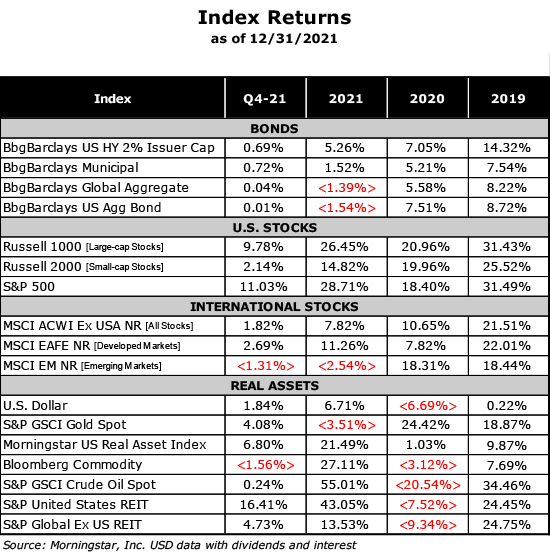
“I’m walking on sunshine, whoa / And don’t it feel good” Katrina and The Waves, “Walking on Sunshine”
One observation that struck us as we compiled the return data above was the fact that 2021 is the first time in 20 years that the S&P 500 has posted a cumulative three-year return greater than 100%. This means that $100 invested in the beginning of 2019 would be worth over $200 at the end of 2021. An important contributing factor to these results is the strong returns from the technology sector. Research shows that the last time the market compounded capital this quickly was in the late 1990s during the Technology Bubble, as shown below in the red circles under the blue column heading:
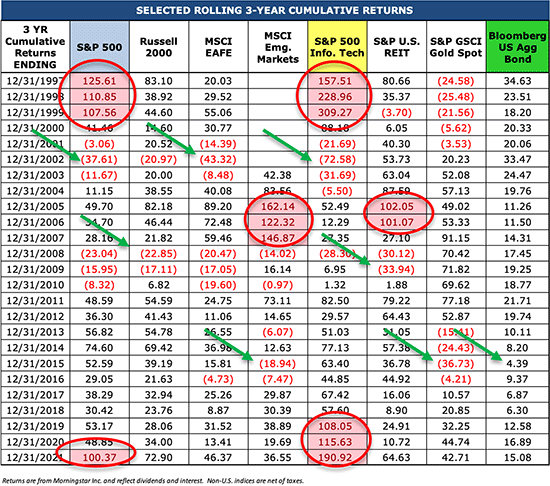
We also noted in red the other indices that had three-year rolling cumulative returns greater than 100%. It’s interesting to note that this select company includes emerging-markets equities, REITs and large-cap technology stocks as represented by the S&P 500 Information Technology sector index. This latter index has the distinction of having six periods of triple-digit cumulative returns, including an eye-popping 309% for the three years ending in December 1999. It also has the honor of the worst three-year cumulative decline ending in December 2002 (the green arrow), during the ‘Tech Wreck’ that occurred after Internet 1.0. The green arrows highlight each index’s worst three-year cumulative return. We can see that all equity-related indices had some substantial cumulative drawdowns. Bonds, in contrast, have never had a negative three-year period, affirming their place in portfolios as a non-correlated asset during times of market pullbacks.
Also of note is the outsized influence the technology sector plays in broader market returns. As the largest sector in the S&P 500 index for several decades, it has provided an important source of market growth, though with high levels of volatility. Technology stocks include names that are popular with consumers but aren’t strictly related to classic industries such as hardware and software. They do incorporate cutting-edge technologies and promote important changes, but they may also promote investor over-confidence and a tendency to fall prey to recency bias (the behavioral trap that what has happened recently will continue). A handful of stocks are also outsized contributors to major indices.
We are tracking the changes in the top-10 names dominance in the S&P 500 index over the past five years. Some of the tech names referenced above are driving this increased concentration. The top-10 allocation originally peaked in 2000, declined steadily in normal growth markets over the next 16 years, and reached new peaks pre-COVID and again in 2021. Clearly driving performance, this concentration may lull investors into overconfidence and to overlook other stocks that are smaller index components.
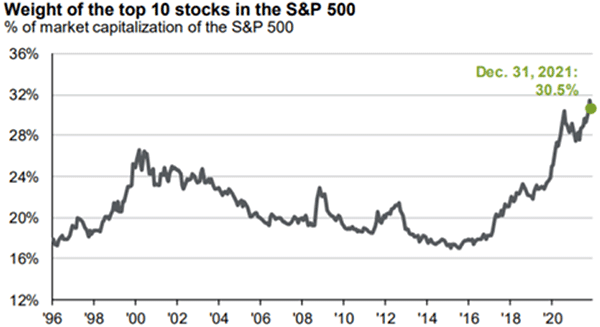
We remain bullish on stocks in this environment but remind investors that this level of concentration and reliance on just a few names to drive returns is cause for caution with respect to expectations.
“Doctor Doctor, gimme the news” Robert Palmer, “Bad Case of Loving You”
The world is moving on from the COVID-19 pandemic as growth recovers and mutated variants move through society. We have been surprised to hear that COVID may be a tailwind at this point, as vaccines have minimized the severity of the more dangerous strains and most economies are committing to remaining open and adjusting social restrictions. This implies that more acceptance of a future booster protocol, while accepting behavioral changes that will reshape the global economy. We should still expect infection waves, however, as the virus continues to mutate and vaccines are not equally distributed around the globe.
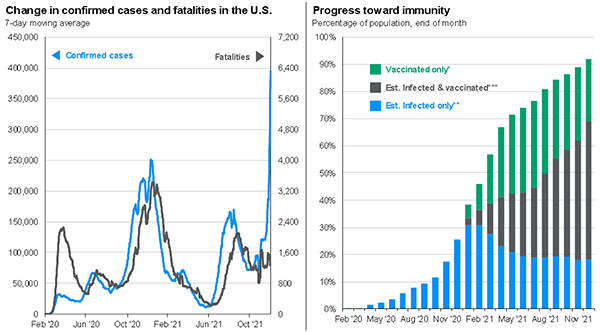
“Well this job I’ve got is just a little too hard / Running out of money, lord, I need more pay / Gonna wake up in the morning lord, gonna pack my bags, / I’m gonna beat it on down the line.” The Grateful Dead, “Beat It On Down The Line”
The jobs recovery continues against the backdrop of The Great Resignation, accelerated Baby Boomer retirements, more people changing jobs and/or demanding higher pay and benefits and continuing hybrid work environments. We expect job growth to continue, and despite growing inflation fears, see the strong recent wage-growth trends as a long-term economic support.
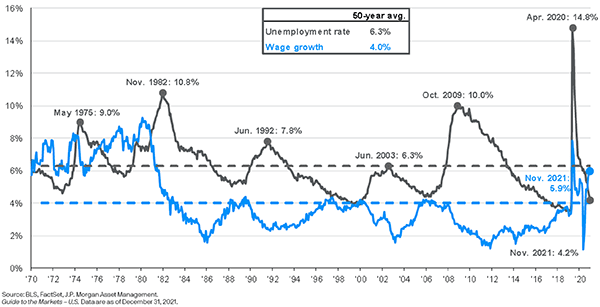
Inflation expectations indicate that core inflation will remain elevated for some time due to variety of global issues including supply-chain disruptions and disproportionate spending on goods versus services as the economy reopens. We expect that consumer spending, driven by drawdowns of pandemic savings and higher wages, will put some pressure on goods and services inflation. We still expect inflation to moderate somewhat as bottlenecks ease but believe the Fed will be less aggressive in fighting inflation than in the past. We also expect some interest-rate increases in 2022, which may negatively affect bond prices in the short term.
“This time tomorrow, where will we be? / This time tomorrow, what will we see?” The Kinks, “This Time Tomorrow”
Our expectations for 2022 are more muted than last year. We expect:
- Slower but good global growth.
- Good returns for U.S. and non-U.S. stocks, but with more volatility and pullbacks than 2021.
- The Fed to gradually begin raising rates. The market is pricing two to four hikes in 2022.
- More geopolitical policy challenges and a change in the U.S. legislature composition after the midterm elections in November, which will present a strong headwind to the Biden agenda.
Many of these are expected changes that have been presaged for some time. They will likely promote some unpleasant volatility, but we remain confident in our ability to manage though them and keep your financial plans on track.
As always, we welcome your comments, questions and feedback. We wish you and your families a healthy, happy and prosperous new year.
—Your Wealth Management Team at JJ Burns & Company
Download Market Commentary
Disclosure: J.J. Burns & Company, LLC is a registered investment adviser with the U.S. Securities & Exchange Commission and maintains notice filings with the States of New York, Florida Pennsylvania, New Jersey, Connecticut, Georgia, Illinois, North Carolina, and California. J.J. Burns & Company, LLC only transacts business in states where it is properly registered, or excluded or exempted from registration. Follow-up and individualized responses to persons that involves either the effecting or attempting to effect transactions in securities, or the rendering of personalized investment advice for compensation, as the case may be, will not be made absent compliance with state investment adviser and investment adviser representative registration requirements, or an applicable exemption or exclusion.
All investing involves risk, including the potential for loss of principal. There is no guarantee that any investment plan or strategy will be successful.
The foregoing content reflects the opinions of J.J. Burns & Company, LLC and is subject to change at any time without notice. Content provided herein is for informational purposes only and should not be used or construed as investment advice or a recommendation regarding the purchase or sale of any security. There is no guarantee that the statements, opinions or forecasts provided herein will prove to be correct.
Past performance may not be indicative of future results. Indices are not available for direct investment. Any investor who attempts to mimic the performance of an index would incur fees and expenses which would reduce returns.
Securities investing involves risk, including the potential for loss of principal. There is no assurance that any investment plan or strategy will be successful.


